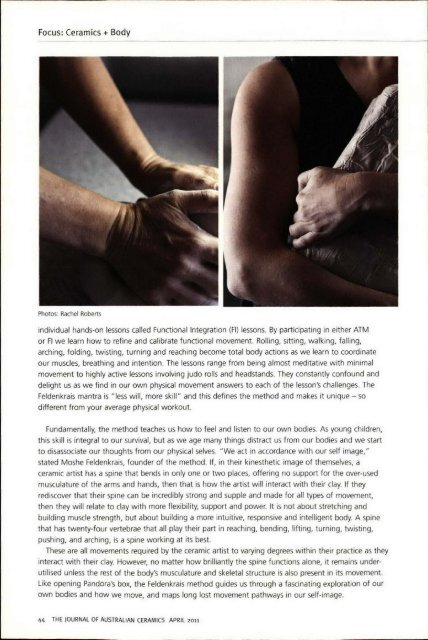The Journal of Australian Ceramics Vol 50 no 1 April 2011
You also want an ePaper? Increase the reach of your titles
YUMPU automatically turns print PDFs into web optimized ePapers that Google loves.
Focus: <strong>Ceramics</strong> + Body<br />
Photos: Rachel Roberts<br />
individual hands-on lessons called Functional Integration (FI) lessons. By participating in either ATM<br />
or FI we learn how to refine and calibrate functional movement. Rolling, sitting, walking, falling,<br />
arching, folding, twisting, turning and reaching become total body actions as we learn to coordinate<br />
our muscles, breathing and intention. <strong>The</strong> lessons range from being almost meditative with minimal<br />
movement to highly active lessons involving judo rolls and headstands. <strong>The</strong>y constantly confound and<br />
delight us as we find in our own physical movement answers to each <strong>of</strong> the lesson's challenges. <strong>The</strong><br />
Feldenkrais mantra is "less will, more skill" and this defines the method and makes it unique - so<br />
different from your average physical workout.<br />
Fundamentally, the method teaches us how to feel and listen to our own bodies. As young children,<br />
this skill is integral to our survival, but as we age many things distract us from our bodies and we start<br />
to disassociate our thoughts from our physical selves. "We act in accordance with our self image,"<br />
stated Moshe Feldenkrais, founder <strong>of</strong> the method. If, in their kinesthetic image <strong>of</strong> themselves, a<br />
ceramic artist has a spine that bends in only one or two places, <strong>of</strong>fering <strong>no</strong> support for the over-used<br />
musculature <strong>of</strong> the arms and hands, then that is how the artist will interact with their clay. If they<br />
rediscover that their spine can be incredibly strong and supple and made for all types <strong>of</strong> movement,<br />
then they will relate to clay with more flexibility, support and power. It is <strong>no</strong>t about stretching and<br />
building muscle strength, but about building a more intuitive, responsive and intelligent body. A spine<br />
that has twenty-four vertebrae that all play their part in reaching, bending, lifting, turning, twisting,<br />
pushing, and arching, is a spine working at its best.<br />
<strong>The</strong>se are all movements required by the ceramic artist to varying degrees within their practice as they<br />
interact with their clay. However, <strong>no</strong> matter how brilliantly the spine functions alone, it remains underutilised<br />
unless the rest <strong>of</strong> the body's musculature and skeletal structure is also present in its movement.<br />
Like opening Pandora 's box, the Feldenkrais method guides us through a fascinating exploration <strong>of</strong> our<br />
own bodies and how we move, and maps long lost movement pathways in our self-image.<br />
44 THE JOURNAL OF AUSTRALIAN CERAMICS APRil <strong>2011</strong>

















